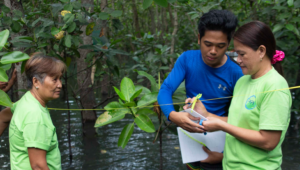Archive: Population, Health, and Environment Toolkit
Archive:
Population, Health, and Environment (PHE) Toolkit
You have reached this page either from the main Toolkits Archive page or because you followed a link to a page or resource that used to be in a K4Health Toolkit. The Toolkits platform has been retired.

People collect data in a mangrove forest. Image credit: PATH Foundation Philippines, Inc.
Population, Health, and Environment (PHE) approaches recognize the relationships between people’s health and the environment. PHE programs seek to improve family planning and reproductive health services as well as conservation and natural resource management through an integrated, community-based, multi-sectoral approach. This Toolkit was designed to host current and high-quality resources for the PHE community and others who are interested in learning more about the PHE approach and integrated development. Since the creation of the PHE Toolkit, “PHE” has largely been replaced by “PED” (Population, Environment, and Development) in international development discourse. Sometimes the two terms are used in combination, PHE/PED. The Toolkit was originally created and updated by the USAID-supported BALANCED Project from 2009-2013. In 2016, the USAID-supported Policy, Advocacy, and Communication Enhanced for Population and Reproductive Health (PACE) project made extensive updates.
Toolkit Alternatives
- Explore a new PHE/PED resource collection which is actively maintained on the People-Planet Connection website, and which inherited many resources from the PHE Toolkit
- Visit 20 Essential Resources for Population, Health, and Environment
- Peruse other Knowledge SUCCESS content about PHE/PED
- Visit past captures of the Population, Health, and Environment Toolkit on the Internet Archive’s Wayback Machine
If you urgently require a specific resource from a retired Toolkit, contact toolkits-archive@knowledgesuccess.org.





